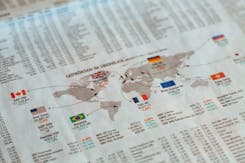What Are Megatrends?
All products and services featured are independently selected by WikiJob. When you register or purchase through links on this page, we may earn a commission.
- What Are the Five Megatrends for Our Future?
empty
empty
empty
empty
empty
- How to Identify Megatrend Investment Opportunities
empty
empty
empty
empty
empty
empty
- Investing in Megatrends
empty
empty
empty
- Frequently Asked Questions
- Final Thoughts
A megatrend is a sustained, irreversible transformation that disrupts the market, leads to innovation and is felt on a global scale.
It is a process that affects the way everyone lives, with economic, societal and cultural ramifications for the whole world.
Megatrends disregard geographical boundaries because they influence factors that concern all people; factors such as healthcare, communications and work.
Megatrends are on-going, allowing the opportunity to observe their effects and development over decades. They have an intensive, far-flung reach into many, perhaps all, areas of people’s day-to-day lives.
What Are the Five Megatrends for Our Future?
In the 21st century, there are a number of identifiable megatrends influencing the present and the likely future.
Undoubtedly, there are areas of overlap between these megatrends, but here are the five megatrends that are the most relevant to investing opportunities right now and likely to be so for decades to come:
1. Technological Advancement
Developments in technology affect many areas of human life, including other megatrends, but technological advancement is also a megatrend in its own right.
For instance:
-
Realising fossil fuels are rapidly depleting led to the search for sustainable replacement energy sources. In turn, this led to the development of solar panels, wind turbines and the ability to harness geothermal energy.
-
Global governments and big business have learned that, for the adoption of electric cars to be at necessary levels to counteract climate change and depleting fossil fuels, it is necessary to drastically alter national infrastructure to make it easy for all to charge.
-
In the world of computers, there is a growing shift to cloud computing as a way for businesses to communicate across their whole organization regardless of employees’ physical location, meaning more people work from home and businesses can save on overheads.
-
An increasing amount of the world’s population has access to the internet, whether through a computer or a mobile device. This has led to an ongoing need for more services and data to be available online, better affordable devices that can handle all that the internet has to offer and more ways to disseminate knowledge and interrogate the internet.
-
The development of 5G has ramifications for all aspects of connectivity, be that autonomous vehicles, smart home devices, augmented reality or simply talking on the phone.
Technological achievements are subject to the ratcheting effect, meaning that advanced technology innately allows the development of more advanced technology.
Technology is constantly providing ways to improve current processes and create new, better methods.
2. Rapid Urbanisation
In 2020, the UN published the results of its research into changes in urbanization, the number of people living in cities, between 1950 and 2020:
- Africa: 14.3% of the continent’s population lived in cities in 1950. By 2020, this had increased to 43.5%
- Asia: 17.5% in 1950 increased to 51.1% in 2020
- Europe: 51.7% in 1950 to 74.9% in 2020
- Latin America and Caribbean: 41.3% in 1950 grew to 81.2% in 2020
- Northern America: 63.9% in 1950 became 83.6% in 2020
As you can see, the biggest growths in urbanization have been seen in Africa and Asia. The UN concluded that since 2010, the majority of the global population has lived in urban areas instead of rural.
3. The Shift in Global Wealth
The shift in global wealth has seen an emerging wealthy middle class in China, increasing wealth in developing countries and dependence of the West on Asia for manufacturing.
China’s increasing investment in its own infrastructure, linked significantly to its drive towards urbanization, and its resulting attractiveness to international business, has seen the country’s gross domestic product (GDP) more than triple between 2000 and 2021.
China’s investment is not only inward. It has also sought to establish and expand trading through Asia and other developing countries, affecting them as well.
4. Demographic and Social Change
There are several factors currently driving the megatrend of demographic and social change:
-
A longer life-expectancy leading to an aging population in many advanced economies and China. In Western Europe, one in five people are over 65 years old. In Japan, this increases to approximately a third of its population. An aging population has ramifications for healthcare, employment and pension provision.
-
There is a rapidly growing population in developing countries. Due to the lack of a matching number of employment opportunities in these countries, this growing population may be forced to emigrate to seek work. Currently, the African continent is seeing the biggest growth in population.
-
Technological developments have automated many processes and altered the way people work. For instance, many car production lines have seen people replaced by machinery. Cloud computing and video conferencing have made it easier to work remotely or from home. Developing technology has created new employment opportunities but with a need for a completely fresh skill set.
5. Climate Change and Resource Scarcity
With global population numbers predicted to reach 8.5 billion by 2030, there is no doubt that an increasing population will place extra pressure on the planet and its resources to provide food, housing, healthcare and employment.
Add to this the challenge of handling environmental issues, such as global warming, rising sea levels and a growing number of extreme weather occurrences, and it becomes clear that this is a megatrend that requires intense scrutinization and rapid action.
Resource scarcity extends beyond what is needed to eat or build homes. It also includes fuel for vehicles and machinery, base components for manufacturing and materials used for day-to-day goods.
This megatrend is not only about climate change and resource scarcity, but also about how these issues must be answered.
How to Identify Megatrend Investment Opportunities
One of the easiest ways to seek investment opportunities in light of these megatrends is to invest in exchange-traded funds (ETF).
An ETF is a collection of securities that can be traded on an exchange. It might include shares, bonds or commodities – in fact, any security that can be exchange-traded.
Just like the securities that it contains, an ETF has a marketable price and can be traded throughout the day.
This helps with megatrend investing because many ETFs are created to take advantage of megatrend-related industries, such as green energy.
You may hear a megatrend ETF described as 'sustainable' or 'thematic' but the best way to find out whether an ETF is linked to a megatrend, or linked to megatrend-related industries, is to drill down into which securities are included in the ETF and then research those securities for yourself.
For instance, if an ETF includes shares from companies that are involved in healthcare or systems that benefit an aging population, or technology linked to the creation of smart cities, this is an indication that the ETF is connected to a megatrend (or two).
There are many ETF providers in the US, but the key players offering megatrend related ETFs are:
Whether you choose to invest by purchasing ETFs or individual stocks and shares, you may want to keep an eye on the following industry areas, as they have all reacted to or evolved because of today’s megatrends:
Renewable Energy
The International Energy Agency (IEA) envisions that renewable energy will become the largest source of electricity generation globally by 2025.
The drive to develop sustainable and affordable renewable energy for all has been created and accelerated by several factors:
- Technologies that have made renewable energy more affordable and more efficient, such as improved wind turbines
- Rapidly growing cities and urban areas that require more energy but at cheaper prices
- Increasing automation of manufacturing processes and reliance on technology
- The damaging effects of current energy sources, such as coal, on the environment and the resulting climate change
- The increasing scarcity of fossils fuels, matched by the increasing expense of sourcing them
The momentum to replace climate-damaging fuel sources with renewable energy has created a whole host of investment opportunities, ranging from green energy suppliers, such as Brookfield Renewable Partners, to manufacturers of solar power equipment, like First Solar, to providers of electric vehicles, like Tesla and General Motors.
Disruptive Technology
Disruptive technology changes the way that businesses, industry sectors and people operate.
The change is often dramatic and completely replaces what has gone before because the new way of doing things is recognizably better.

The five megatrends described in this article have all resulted in disruptive technology.
For instance:
-
Technological advancement allowed more efficient and less expensive electric vehicle batteries to be developed, bringing forward the possibility of electric cars becoming the norm.
-
Rapid urbanization drove the need for improved connectivity, resulting in the 5G network.
-
Climate change persuaded much of the global population and many of the world’s governments that moving to cleaner energy sources is the way forward, instead of continuing with coal, oil and gas. The resulting disruptive technologies have been linked to new cleaner power sources, such as developing more efficient solar power cells.
Investing in the businesses and industries involved in the development of disruptive technology is your chance to get in at the beginning of a wave of disruption. Imagine if you had invested in Tesla at the beginning.
Space Travel
Space travel as a norm may seem out of reach for the majority at the moment, but research and developments towards that future have been key in many of the technological advances over the last decade or so.
For instance, satellite communications have enabled the commonly available GPS devices that most rely on nowadays to get around, and research on the International Space Station has led to improved water purification systems and advances in healthcare.
Future developments in the space arena are likely to include:
- Elon Musk’s efforts to establish a colony on Mars
- Space tourism opportunities provided by businesses such as Virgin Galactic
- The race by countries around the globe to replace the International Space Station, should it be retired after 2028
Whether humans achieve interplanetary colonization or stay Earth-bound, the investigation into space offers many opportunities to invest.
Digital Security
The importance of digital security has seen a greater focus in recent years, largely caused by:
- The move to working in the cloud, remotely and from home
- The increase of online shopping and monetary transactions, including banking
- The fact that most people have access to a computer or mobile device
- The growing popularity of smart devices
- The increasingly complicated nature of cyber threats
Investment opportunities in this industry include not only the businesses that develop digital security tools but also digital security insurers like Hiscox.
Healthcare Innovation
The healthcare sector is seeing a massive shift as it faces the prospect of an on-going aging population, placing a focus on related illnesses and conditions as well as longer health maintenance.
Economic efficiency is an increasing concern.
Patient data is key to the healthcare sector and as such data handling, whether the collection, storage or transfer, is ripe for innovation.
Add to this the number of disease outbreaks that have hit the world over the last 20 years, such as ebola, bird flu and, most recently, COVID-19, and the resulting need to develop treatments and vaccinations, and there is no doubt that investing in healthcare innovation is a sensible route to take.
Education
The structure of school and college education has changed little over the last 80 years, but the area of online education has seen a rapid expansion, and not just since the COVID pandemic began.
The application of education-related technology is vast, including:
- Online classroom learning when face-to-face learning is difficult or impossible
- Adult online courses, supervised or self-monitored, especially those that operate outside the typical working day
- Tailoring online teaching to the students’ needs and preferences; for instance, choosing the media that works best for a student – video, interactive or text – or providing automatically subtitled videos for deaf students
- Teaching across distances, whether local, national or even international
- On-demand learning at the student’s own pace
There is also the need to maintain privacy and security when using educational tools online, especially in the case of children and teens. This ties into digital security, mentioned above.
Investment in this sector, especially EdTech companies, saw a surge in 2020 despite the disruption caused by the Covid-19 pandemic in other areas.
Roblox might not be the first name you think of when it comes to education, but it proved to be one of the biggest education-related draws in investment.
Other leading names include Coursera, MasterClass and Brainly.
Investing in Megatrends
Now that you know what megatrends are and how to identify related investment opportunities, here are some top tips for investing in megatrends:
Know the Risks
First, high numbers of individual traders (often referred to as retail traders), who are not necessarily as well informed as many professional traders, often lead to a surge in megatrend-related securities, which results in over-valuation and volatility.
Second, as with any other investment you make, it is always necessary to monitor performance.
Do not rely on an investment continuing to perform well just because it is related to a megatrend.
Invest Gradually
It is always advisable to invest gradually in a market that you are unfamiliar with, perhaps because it is new or developing.
Remember, you are investing in the future and sometimes the future changes course.
Know the Warning Signs
Getting to know the warning signs of a bad investment is a skill that comes with experience, but there are some you should be aware of from the outset:
- ‘Guaranteed’ high returns that seem too good to be true
- A financial advisor who fails to achieve your targeted return so moves the goalposts instead
- Withdrawals that take too long to be processed
- No active market for your investments when you want to sell, meaning that no one wants to buy them from you
- The value of dividends drop meaning that the company is struggling financially, which may result in the price of their shares dropping too
- A procession of management departures from the company may indicate problems
- A too low price-to-earnings ratio
Also keep in mind that, while it is less likely with megatrends, trends can reverse.
Frequently Asked Questions
Megatrends are large, long-term shifts in societal and economic behavior that can have a profound impact on the world.
They are driven by a combination of technological, economic, social and political factors, and can last for decades or even centuries.
Examples of megatrends include globalization, climate change, demographic shifts and the rise of digital technology.
Megatrends differ from other types of trends in that they are generally more far-reaching and longer-lasting.
While other trends may last for a few months or a few years, megatrends can have a significant impact on society and the economy for decades or even centuries.
Megatrends are also often driven by a combination of factors, rather than a single trend.
Some examples of megatrends include the rise of digital technology, demographic shifts such as aging populations and urbanization, climate change and resource scarcity, and the growing importance of sustainability and corporate social responsibility.
Investing in megatrends can be done in a number of ways, including investing directly in companies that are positioned to benefit from the trend, investing in exchange-traded funds (ETFs) that focus on a particular megatrend or investing in mutual funds that have a specific focus on megatrends.
Traders can identify and analyze megatrends by looking at macroeconomic factors such as demographic shifts, technological developments and political changes.
They can also use technical analysis to identify long-term trends in the market and track the performance of stocks and other assets that are likely to benefit from a particular megatrend.
Some successful examples of megatrend trading include investing in technology companies during the rise of digital technology, investing in renewable energy companies during the shift towards sustainability and investing in healthcare companies during the aging of the population.
Traders can incorporate megatrend analysis into their overall trading strategy by identifying the megatrends that are most relevant to their particular market or sector, and then using that information to make informed decisions about when and where to invest.
They can also use technical analysis to identify specific stocks and assets that are likely to perform well in the context of a particular megatrend.
Megatrends can last for decades or even centuries, depending on the factors driving the trend and the pace of technological, economic and social change.
Some megatrends, such as demographic shifts, can last for generations, while others, such as technological innovations, may evolve rapidly over a shorter time frame.
Megatrends are studied and predicted by a range of experts, including economists, social scientists and futurists.
These experts use a variety of tools and methods to analyze current and emerging trends, and to make predictions about how those trends are likely to evolve over time.
Investing in megatrends can be a long-term or a short-term strategy, depending on the particular megatrend and the investor's goals and risk tolerance.
Some megatrends, such as demographic shifts, are likely to be long-term and may require a longer investment horizon, while others, such as technological innovations, may evolve more quickly and offer shorter-term opportunities for investors.
There are several platforms available for investing in megatrends, each with their own features and benefits.
Some of the popular platforms include BlackRock's iShares Megatrends ETF, Global X's Thematic Growth ETFs and ARK Invest's suite of thematic ETFs.
Additionally, many online brokers also offer access to these types of funds.
When selecting a platform, it's important to consider factors such as fees, investment minimums and the specific megatrends or themes that the platform focuses on.
While megatrends generally represent long-term shifts or opportunities for growth, they can also have negative consequences.
For example, the megatrend of automation and artificial intelligence may lead to job loss or other societal impacts.
Similarly, the megatrend of climate change may result in negative consequences such as natural disasters, food and water scarcity, and economic disruption.
It's important for investors to consider both the potential benefits and risks associated with megatrends before investing, and to ensure that their investment strategy aligns with their personal values and goals.
Final Thoughts
The five megatrends described in this article are undeniably present and continuing to develop. They affect people’s way of life now and will do for many years to come.
Investing in a trend may seem like the intuitive thing to do, but as with any investment, a level of research and monitoring is always required to safeguard your money.
WikiJob does not provide tax, investment or financial services and advice. The information is being presented without consideration of the investment objectives, risk tolerance or financial circumstances of any specific investor and might not be suitable for all investors. Past performance is not indicative of future results. Investing involves risk including the possible loss of principal.





